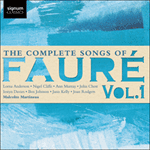If
Automne is richly textured and low in tessitura,
La fée aux chansons is its mirror-image and opposite. Ever since Gerald Moore selected this song to be performed at his eightieth birthday concert twenty-five years ago, this shy and neglected song of aerial enchantment has been a personal favourite. Of course it has the faults of the sweeter Silvestre settings, a kind of winsomeness which borders on (but does not fall into) the sugary trap of many of the Massenet songs. (The harmonic structure of the piece is too strong and well planned for the structure to collapse into the shapelessness which undermines that composer’s mélodies.) Of course the poem is nonsense, but it is a cleverly crafted confection, and a perfect shape (and length) for a fast song that uses one fleet syllable after the other. Silvestre was right to place it in his ‘Vers pour être chantés’ (in
Les ailes d’or). Fauré is usually a composer wedded to his bass lines, but occasionally, in the interests of lightness and brightness he transports us (as in some of his piano music) into the higher regions of the treble clef. The listener is sprinkled with glistening stardust, and Fauré earns his nickname as ‘The Master of Charms’. But the music contains a very special surprise. This is the music for the poem’s fourth verse. We have been delighted by the lightness of the fairy’s tread in spring and summer, but autumn brings different music. For fourteen bars (marked
molto meno mosso) we enter another harmonic sphere. Fauré allows himself (ever aware, and perhaps with a rueful smile) to broach Debussy’s world of mists and mysterious allusion. Here mellowness contrasts with the glitter of what has gone before – a ravishingly beautiful interlude; but Fauré does not allow himself to dally long in his rival’s territory. A swift rise of triplets transports us out of the autumnal reverie and the flight of the swallows sweeps us up from the doldrums with precipitous grace. The postlude of this very superior piece of salon music (Chaminade could only have dreamed of writing a song like this) is feather-light and ineffably charming.
from notes by Graham Johnson © 2005
La fée aux chansons est l’image spéculaire, le contraire d’
Automne et de sa texture riche, de sa tessiture grave. Depuis que Gerald Moore l’a choisie, voilà un quart de siècle, pour le concert de ses quatre-vingts ans, cette mélodie timide et oubliée, toute d’enchantement éthéré, est devenue l’une de mes préférées. Bien sûr, elle a les défauts des très douces mises en musique de textes de Silvestre, un certain charme qui manque, mais manque seulement, de tomber dans le chausse-trape mièvre de maintes mélodies de Massenet. (La structure harmonique de la pièce est ici bien trop solide, trop bien conçue, pour que l’édifice sombre dans le caractère informe qui sape ces dernières.) Bien sûr, le poème n’a pas de sens, mais c’est une friandise intelligemment ciselée, de forme (et de longueur) parfaite pour une mélodie preste, enchaînant les syllabes rapides. Silvestre eut raison de l’intégrer dans ses «Vers pour être chantés» (in
Les ailes d’or). D’ordinaire véritablement marié à ses lignes de basse, Fauré nous emmène parfois (comme dans certaines de ses œuvres pour piano), par souci de légèreté et de clarté, dans les hautes sphères de la clef de sol. L’auditeur est saupoudré d’illusions luisantes, qui valent à Fauré d’être surnommé «Le maître des charmes». Mais la musique renferme une surprise toute particulière, à la quatrième strophe du poème. Le pas léger de la fée, au printemps et à l’été, nous a charmés, mais l’automne draîne une musique bien différente: en quatorze mesures (marquées
molto meno mosso), nous pénétrons dans une autre région harmonique. Toujours conscient, mais peut-être avec un sourire chagrin, Fauré s’autorise à aborder l’univers de brume et d’allusion mystérieuse de Debussy. La douceur de ce moment contraste avec l’éclat de ce qui s’est déroulé auparavant – un interlude d’une ravissante beauté. Mais Fauré ne se permet pas de lanterner longtemps sur le territoire de son rival: une prompte montée de triolets nous arrache à cette rêverie automnale et le vol des hirondelles nous entraîne loin du pot au noir, avec une grâce précipitée. Le postlude de cette musique de salon des plus supérieures (Chaminade n’eût pu que rêver d’écrire pareille mélodie) est léger comme une plume, d’une grâce ineffable.
extrait des notes rédigées par Graham Johnson © 2005
Français: Hypérion


 Fauré: The Complete Songs, Vol. 1
Fauré: The Complete Songs, Vol. 1
